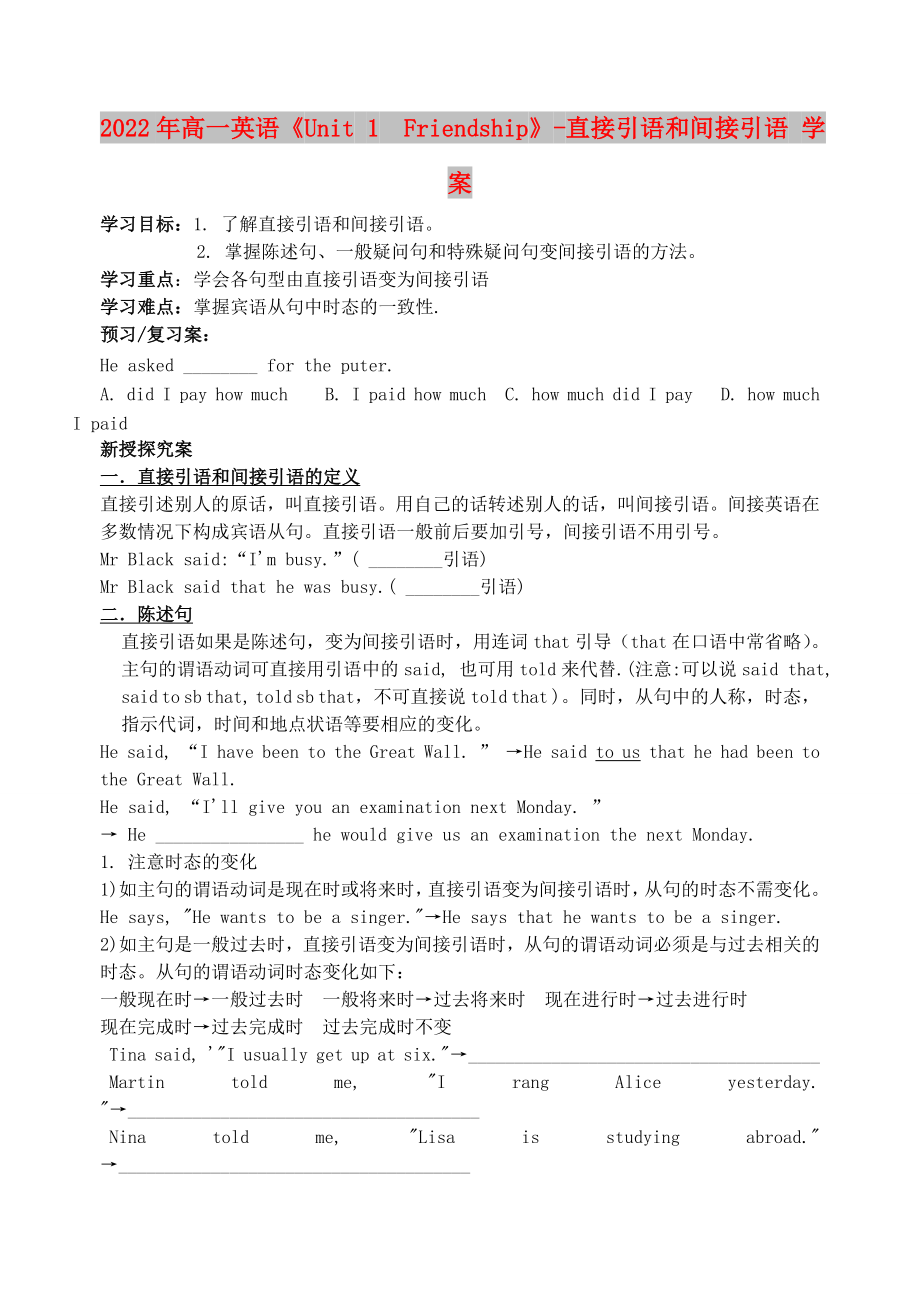《2022年高一英語(yǔ)《Unit 1Friendship》-直接引語(yǔ)和間接引語(yǔ) 學(xué)案》由會(huì)員分享,可在線(xiàn)閱讀�,更多相關(guān)《2022年高一英語(yǔ)《Unit 1Friendship》-直接引語(yǔ)和間接引語(yǔ) 學(xué)案(3頁(yè)珍藏版)》請(qǐng)?jiān)谘b配圖網(wǎng)上搜索�。
1�����、2022年高一英語(yǔ)Unit 1 Friendship-直接引語(yǔ)和間接引語(yǔ) 學(xué)案學(xué)習(xí)目標(biāo):1. 了解直接引語(yǔ)和間接引語(yǔ)�����。 2. 掌握陳述句�、一般疑問(wèn)句和特殊疑問(wèn)句變間接引語(yǔ)的方法。學(xué)習(xí)重點(diǎn):學(xué)會(huì)各句型由直接引語(yǔ)變?yōu)殚g接引語(yǔ)學(xué)習(xí)難點(diǎn):掌握賓語(yǔ)從句中時(shí)態(tài)的一致性.預(yù)習(xí)/復(fù)習(xí)案: He asked _ for the puter. A. did I pay how much B. I paid how much C. how much did I pay D. how much I paid新授探究案一直接引語(yǔ)和間接引語(yǔ)的定義直接引述別人的原話(huà)�����,叫直接引語(yǔ)�。用自己的話(huà)轉(zhuǎn)述別人的話(huà),叫間接引語(yǔ)����。間接英語(yǔ)
2、在多數(shù)情況下構(gòu)成賓語(yǔ)從句���。直接引語(yǔ)一般前后要加引號(hào)����,間接引語(yǔ)不用引號(hào)。Mr Black said:“Im busy.”( _引語(yǔ))Mr Black said that he was busy.( _引語(yǔ))二陳述句直接引語(yǔ)如果是陳述句���,變?yōu)殚g接引語(yǔ)時(shí)���,用連詞that引導(dǎo)(that在口語(yǔ)中常省略)。主句的謂語(yǔ)動(dòng)詞可直接用引語(yǔ)中的said, 也可用told來(lái)代替.(注意:可以說(shuō)said that, said to sb that, told sb that���,不可直接說(shuō)told that )�。同時(shí)�����,從句中的人稱(chēng)���,時(shí)態(tài)��,指示代詞,時(shí)間和地點(diǎn)狀語(yǔ)等要相應(yīng)的變化���。He said, “I have been
3�����、to the Great Wall. ” He said to us that he had been to the Great Wall. He said, “Ill give you an examination next Monday. ” He _ he would give us an examination the next Monday. 1. 注意時(shí)態(tài)的變化 1) 如主句的謂語(yǔ)動(dòng)詞是現(xiàn)在時(shí)或?qū)?lái)時(shí)�,直接引語(yǔ)變?yōu)殚g接引語(yǔ)時(shí),從句的時(shí)態(tài)不需變化�����。He says, He wants to be a singer.He says that he wants to be a singer
4�����、.2) 如主句是一般過(guò)去時(shí)�,直接引語(yǔ)變?yōu)殚g接引語(yǔ)時(shí),從句的謂語(yǔ)動(dòng)詞必須是與過(guò)去相關(guān)的時(shí)態(tài)����。從句的謂語(yǔ)動(dòng)詞時(shí)態(tài)變化如下:一般現(xiàn)在時(shí)一般過(guò)去時(shí) 一般將來(lái)時(shí)過(guò)去將來(lái)時(shí) 現(xiàn)在進(jìn)行時(shí)過(guò)去進(jìn)行時(shí) 現(xiàn)在完成時(shí)過(guò)去完成時(shí) 過(guò)去完成時(shí)不變 Tina said, I usually get up at six._ Martin told me, I rang Alice yesterday. _ Nina told me, Lisa is studying abroad. _Nell said, I have worked out this problem. _2. 注意人稱(chēng)變化,指示代詞���,時(shí)間狀語(yǔ)����,地點(diǎn)狀語(yǔ)和動(dòng)
5�����、詞的變化指示代詞 thisthat, thesethose, 時(shí)間狀語(yǔ)nowthen, todaythat day, this weekthat week, yesterdaythe day before, last weekthe week before ,four days agofour days before ,the day before yesterday two days before ,tomorrowthe next day, next monththe next month.地點(diǎn)狀語(yǔ)herethere 動(dòng)詞的變化ego, bringtakeHe said, I like i
6、t very much._Toby said to me, This is the School puter Center._The boy said, I put all the things there._My sister asked me, Could you bring the chairs upstairs��?_注意:直接引語(yǔ)變間接引語(yǔ)時(shí)���,以下情況時(shí)態(tài)不需變化����。1. 直接引語(yǔ)表述的是客觀真理,諺語(yǔ)�����、格言The geography teacher told us that the sun rises in the east and sets in the west.My father
7��、told me that a friend in need is a friend indeed.2. 直接引語(yǔ)帶有具體的過(guò)去時(shí)間狀語(yǔ) He said that his father was born in 1995.3. 直接引語(yǔ)中有情態(tài)動(dòng)詞should, would, could, had better, might, must, need�,used to等 He told me that I had better get up early.4. 當(dāng)直接引語(yǔ)中有以when, while引導(dǎo)的從句,表示過(guò)去的時(shí)間時(shí) He told me that he was watching TV whe
8�、n he came in.三疑問(wèn)句如果直接引語(yǔ)是疑問(wèn)句,變?yōu)殚g接引語(yǔ)時(shí)���,要把疑問(wèn)句語(yǔ)序變?yōu)殛愂鼍湔Z(yǔ)序(即主語(yǔ)在謂語(yǔ)的前面)1)一般疑問(wèn)句 間接引語(yǔ)用連詞whether或if引導(dǎo)�����,原主句中謂語(yǔ)動(dòng)詞said要改為asked(me/him/us等)�,疑問(wèn)句語(yǔ)序變?yōu)殛愂鼍涞恼Z(yǔ)序 He said, “Do you have any difficulty with pronunciation?” He asked (me) whether/if I had any difficulty with my pronunciation. He said, “Are you interested in Engli
9��、sh?” He _interested in English. 2)特殊疑問(wèn)句 原來(lái)的疑問(wèn)詞作為間接引語(yǔ)的連詞���,主句的謂語(yǔ)動(dòng)詞用ask(sb. )來(lái)表達(dá)���,疑問(wèn)句語(yǔ)序改為陳述句語(yǔ)序 He said to me,“Whats your name?” He asked me what my name was. He asked us, “How many car factories have been built in your country?” He asked us_3) 選擇疑問(wèn)句 用whetheror表達(dá)���,而不用ifor����,也不用eitheror He asked, “Do you spea
10��、k English or French?” He asked me whether I spoke English or French. 當(dāng)堂檢測(cè)案:把下列直接引語(yǔ)改為間接引語(yǔ)1He said: “Ive left my book in my room.”2She said: “He will be busy.” 3She said to Tom, “Can you help me?”4She asked, “Is this book yours or his?”5The teacher asked, “how did you repair it?”課后練習(xí)案:完成導(dǎo)學(xué)案直接引語(yǔ)和間接引語(yǔ)(2)學(xué)后感:
 2022年高一英語(yǔ)《Unit 1Friendship》-直接引語(yǔ)和間接引語(yǔ) 學(xué)案
2022年高一英語(yǔ)《Unit 1Friendship》-直接引語(yǔ)和間接引語(yǔ) 學(xué)案

